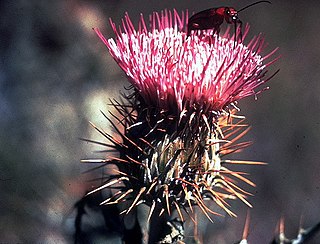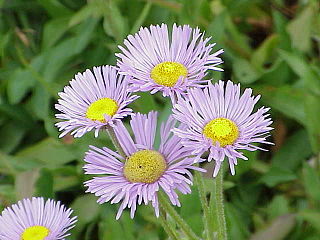
Chrysothamnus, known as rabbitbrush, rabbitbush, and chamisa, are a genus of shrubs in the family Asteraceae. The native distribution is in the arid western United States, Canada, and northern Mexico. It is known for its bright white or yellow flowers in late summer.

Ericameria nauseosa, commonly known as chamisa, rubber rabbitbrush, and gray rabbitbrush, is a shrub in the sunflower family (Aster) found in the arid regions of western North America.

Chaenactis is a genus of plants in the family Asteraceae which are known generally as pincushions, sussymoguses and dustymaidens.

Cirsium neomexicanum is a North American species of thistle known by the common names New Mexico thistle, powderpuff thistle, lavender thistle, foss thistle and desert thistle.

Cirsium occidentale, with the common name cobweb thistle or cobwebby thistle, is a North American species of thistle in the family Asteraceae.

Hymenopappus filifolius is a North American species of flowering plant in the daisy family known by the common names fineleaf hymenopappus and Columbia cutleaf. It is native to western and central North America from Alberta and Saskatchewan south as far as Chihuahua and Baja California.

Cirsium cymosum is a North American species of thistle known by the common name peregrine thistle. It is native to the western United States, where it has been found in California, Oregon, Nevada, Utah, Idaho, Wyoming, and Montana.

Cirsium ochrocentrum is a species of thistle known by the common name yellowspine thistle. It is native to the Great Plains of the Central United States and to the desert regions of the western United States and northern Mexico. Its range extends from eastern Oregon east to the Black Hills of South Dakota, south as far as the Mexican State of Durango.

Crepis occidentalis is a North American species of flowering plant in the family Asteraceae known by the common names western hawksbeard, or largeflower hawksbeard. It is native to western Canada and the western United States.

Crepis runcinata is a North American species of flowering plant in the family Asteraceae known by the common name fiddleleaf hawksbeard. It is native to western and central Canada, the western and central United States and northern Mexico (Chihuahua).

Dieteria canascens is an annual plant or short lived perennial plant in the family Asteraceae, known by the common names hoary tansyaster and hoary-aster.

Eucephalus is a genus of North American flowering plants in the family Asteraceae.

Cirsium eatonii, commonly known as Eaton's thistle or mountaintop thistle, is a North American species of flowering plants in the family Asteraceae.

Erigeron pumilus, the shaggy fleabane, or vernal daisy, is a hairy North American species of perennial plants in the family Asteraceae. It is widespread across much of western Canada and the western United States, from British Columbia east to Saskatchewan and south as far as Oklahoma and the San Bernardino Mountains of California. There have been reports of the plant growing in Yukon Territory, but these were based on misidentified specimens.

Brickellia microphylla, the littleleaf brickellbush, is a flowering plant species in the family Asteraceae native to western North America.

Arnica lanceolata is a North American species of flowering plant in the family Asteraceae, known by the common name clasping arnica or lanceleaf arnica. It has a disjunct (discontinuous) distribution in western North America and northeastern North America.

Cirsium clavatum, the Fish Lake thistle or fringed thistle, is a North American species of plants in the tribe Cardueae within the family Asteraceae. The species is native to the western United States, the States of Wyoming, Colorado, Utah, Arizona, and New Mexico.

Cirsium hookerianum, common name Hooker's thistle or white thistle, is a North American species of thistle native to western Canada and the northwestern United States. It is found in the northern Rocky Mountains as well as in some of the northern Cascades and Coast Ranges, in Alberta, British Columbia, Washington, Idaho, Montana, and Wyoming.
Cirsium pulcherrimum, the Wyoming thistle , is a North American species of plants in the tribe Cardueae within the family Asteraceae. The species is native to the western United States, primarily in the state of Wyoming but also in surrounding areas.

Erigeron glabellus is a North American species of flowering plants in the family Asteraceae, called the streamside fleabane.




















